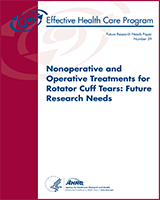NCBI Bookshelf. A service of the National Library of Medicine, National Institutes of Health.
Butler M, Forte M, Braman J, et al. Nonoperative and Operative Treatments for Rotator Cuff Tears: Future Research Needs: Identification of Future Research Needs From Comparative Effectiveness Review No. 22 [Internet]. Rockville (MD): Agency for Healthcare Research and Quality (US); 2013 Feb. (Future Research Needs Papers, No. 39.)
This publication is provided for historical reference only and the information may be out of date.

Nonoperative and Operative Treatments for Rotator Cuff Tears: Future Research Needs: Identification of Future Research Needs From Comparative Effectiveness Review No. 22 [Internet].
Show detailsA select group of rotator cuff tear experts, professional organization representatives, funders payers, and consumers showed a high level of agreement in identifying the overarching question of, “which treatment is best for which patients, and when.” A large proportion of patients with rotator cuff tears could potentially be treated nonoperatively or operatively. In the context of unresolved rotator cuff questions, surgical technique questions were superseded by questions about which patients actually require surgery. However, much of the current rotator cuff research (Appendix B Table 1) focuses not on areas of top priority for stakeholders, but instead on aspects of rotator cuff care that can be more quickly or easily evaluated. For example, studies have tended to be short-term examinations of technique or surgical augmentation rather than more difficult-to-conduct RCTs or prospective cohort studies. Consistent with conference call themes, stakeholder rankings emphasized that any research undertaken to address the scientific questions should be conducted with an eye to moving the field forward. That is, it must address the overarching question of best treatment choice and timing for specific patients.
Answers to the scientific questions listed by the stakeholders will depend on resolving the methodological issues that have thus far plagued the literature. Inconsistencies in the use of outcomes tools and terms, along with study conduct flaws, have resulted in excessive variability in treatment results. This variability makes it difficult to determine the true results “signal” from other research “noise.” Meticulously following the Consolidated Standards of Reporting Trials (CONSORT) recommendations2 and improving inconsistencies in reporting would improve the quality of future rotator cuff studies. As recommended in the original systematic review, future clinical investigation should utilize comparison groups where possible. The usefulness of future rotator cuff research efforts will be dramatically advanced by consistent improvements in the conduct and reporting of clinical studies that include clear definitions of pathology, use consistent outcomes tools, and include ample baseline information on patients and pathology.
The successful treatment of rotator cuff tears often requires multispecialty professional efforts. Therefore, removing methodological roadblocks to advancing the research will require multidisciplinary consensus to improve the comparability and utility of rotator cuff clinical research findings for providers and patients. No single study will answer the broader rotator cuff treatment questions. Multicenter, even multinational, efforts are imperative to improve the clinical utility of the information produced by these studies. However, consensus on methods issues and adoption of the consensus recommendations across health care disciplines will create a solid foundation from which higher comparability investigations can emerge.
In order for valid conclusions about which treatments work best in defined patient subgroups, future studies should use outcomes assessment tools and a reliable set of baseline patient variables. This would lead to greater comparability of populations and outcomes across studies. Establishing minimum clinical differences for outcomes will ensure that researchers can accurately determine whether statistically significant differences are clinically meaningful. At a minimum, researchers should use agreed-upon outcomes tools and the full set of recommended baseline variables so that outcomes from small rotator cuff studies can be pooled, allowing for systematic reviews and meta-analyses to identify overarching effects.
To improve the quality of rotator cuff research, and ultimately of patient care, consistent definitions and terms for rotator cuff pathology are essential across nonoperative, operative, and diagnostic/radiologic providers. Additionally, the selection of a consistent set of outcomes assessment tools for use across multiple categories of providers will enhance the comparability and utility of research findings so that the most successful treatments can be applied at the right time and in the right patients.
A primary concern of consumers across the spectrum of rotator cuff evaluation and treatment was the way in which provider specialization, or lack thereof, affected rotator cuff diagnoses and treatments. Although brief summary comments were made on provider effects in the systematic review, stakeholders in this project identified potential provider quality and expertise differences in treatment and outcomes across the full range of diagnostic, nonoperative, and operative providers. Provider quality issues may emerge as the rotator cuff research foundation becomes more clearly established, particularly among patients with complex pathology.
This project’s strengths lie in the multidisciplinary perspective brought by the broad stakeholder participation. Stakeholders from orthopedic surgery, physical therapy, massage therapy, research program funders, provider organizations, and consumers, contributed insights toward a cohesive set of recommendations. Consumer input illuminated the needs and priorities of consumers in rotator cuff research and treatment choices, and the impact of the current substandard rotator cuff tear research base on patient care.
Although the experts who participated in this project were selected as representative of broader professional and research groups with rotator cuff tear interests, the prioritization activity was limited to a small sample, and the results may not reflect the priorities of the general stakeholder populations. The sample size was limited by the Paperwork Reduction Act and Information Collections Policy (44 USC 3501-3520), administered by the Office of Management and Budget.3 The Act was designed to minimize the paperwork burden on the public, assure that high quality data are obtained, and minimize costs. However, the approval process to allow greater than nine nongovernment participants exceeded the length of time available to complete the project.
- Discussion - Nonoperative and Operative Treatments for Rotator Cuff Tears: Futur...Discussion - Nonoperative and Operative Treatments for Rotator Cuff Tears: Future Research Needs
Your browsing activity is empty.
Activity recording is turned off.
See more...